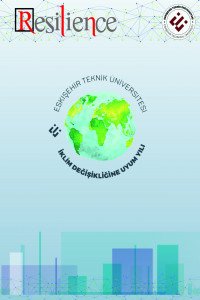Türkiye’nin Ulusal Afet ve Acil Durum Yönetim Sisteminin Mevcut Hali ve Yeni Bir Yönetim Modeli Önerisi
Bütünleşik Afet ve Acil Durum Yönetimi, AFAD, Dayanıklılık, Yeni Başkanlık Sistemi, Türkiye
Current Situation of Turkey's National Disaster and Emergency Management System and a Suggestion for a New Management Model
Comprehensive Disaster and Emergency Management, Presidential Management System, Resilience, Turkey,
___
- EMERCOM. (2012). EMERCOM of Russia Country Report. https://www.adrc.asia: https://www.adrc.asia/countryreport/RUS/RUSeng98/index.html adresinden alındı
- Emergency Management Institute, USA. (2014). Comparative Emergency Management Book. Washington DC: FEMA.
- European Commision. (2019). Vademecum of Civil Protection - European Commision. http://ec.europa.eu: http://ec.europa.eu/echo/files/civil_protection/vademecum/fr/2-fr.html adresinden alındı
- Federal Disaster Management Agency. “State Organization and Role in Emergency Management.” Last modified May 28, 2014b. (2014). http://www.fema.gov/about-agency. . adresinden alındı
- Federal Office of Civil Protection and Disaster Assitance. (2018). Federal Office of Civil Protection and Disaster Assitance. https://www.bbk.bund.de: https://www.bbk.bund.de/EN/FederalOffice/Chronicle/chronicle_node.html adresinden alındı
- Government of Japan. (2007). Disaster Management System in Japan. Tokyo: Government of Japan.
- Index for Risk Management (INFORM). (2019). 2019 shared evidence for managing crises and disasters. INFORM.
- İTÜ. (2005). Ulusal Acil Durum Yönetim Modeli. Istanbul: İTÜ Press.
- Kapucu, N. (2008). Collaborative emergency management: better community organising, better public preparedness and response. Disasters, s. 249.
- Kapucu, N. (2010). Disaster and Crisis Management in Turkey: A Need for a Unified Crisis Management System. Disaster Prevention and Management.
- Leblebici, Ö. (2014). Afetlerde Kamu Yönetimnin Rolü ve Toplum Temellik Afet Yönetimine Doğru. Hitit Üniversitesi Sosyal Bilimler Enst. Dergisi, 457-477.
- Liyanaarachchige, C. (2016). A Study on the Disaster Management Framework of Japan. Tokyo: Asian Disaster Reduction Center.
- Ozdamar, E., & Kadıoglu, M. (2008). Afet Zararlarını Azaltmanın Temel İlkeleri. ANKARA: JICA.
- Rubin, C. (2007). Emergency Management: The American Experience 1900-2005. Fairfax: PERI.
- Seneviratne, D. B. (2011). Disaster knowledge factors in managing disasters. International Journal of Strategic Property Management, s. 380.
- Şener, S. I. (2003). Ulusal Acil Durum Yönetimi Modeli,. ITU Press,.
- TC İçişleri Bakanlığı. (2019). İçişleri Bakanlığı. www.https://www.icisleri.gov.tr. adresinden alındı
- Tercan, B. (2018). Türkiye’de afet politikaları ve kentsel dönüşüm ...Abant Kültürel Araştırmalar Dergisi - Abant Journal of Cultural Studies, 3-19.
- UNDRR. (2019). UN Office for Disaster Risk Reduction ( UNDRR). https://www.unisdr.org: https://www.unisdr.org/partners/countries/fra adresinden alındı
- Varol, E. B. (2017). Afetler Karşısında Toplum Dirençliliği. Jurnal of Resilience.
- Yaman, E. A. (2019). Türkiye Afet ve Acil Durum Yönetimi Sistemi için Bir Değerlendirme. IDRC 2019 Makale özeti sunumu. Eskişehir: IDRC 2019.
- Yayın Aralığı: Yılda 2 Sayı
- Başlangıç: 2017
- Yayıncı: Eskişehir Teknik Üniversitesi
Kültürel Miras Alanlarının Korunması ve Afet Yönetimi İlişkisi
Sinem OKTAY, Nilüfer TAŞ, Murat TAŞ
Kentsel Dayanıklılık Odaklı Planlama Yaklaşımının Türk Kent Planlama Sistemine Uyarlanması
Mediha Burcu SILAYDIN AYDIN, Nur Sinem PARTİGÖÇ, Hayat ZENGİN ÇELİK, Hilmi Evren ERDİN
17-18 Temmuz 2019 Akçakoca ve Cumayeri (Düzce) Sel Afeti Sonuçları ve Müdahale Çalışmaları
Hüseyin BAYRAKTAR, Elif SAHTİYANCI
Kentsel Planlamada İklim Direnci Teması; Ankara Örneği
Akut Şok ve Kronik Stresler Karşısında Kentsel Dayanıklılık & Sürdürülebilir Dayanıklılık Yaklaşımı
Kamran JAFARPOUR GHALEHTEİMOURİ, Moosa KAMANROODİ KOJOURİ
Afet Kriz Yönetiminde Sosyal Medyanın İşlevselliği ve Zararları Üzerine Bir İnceleme
